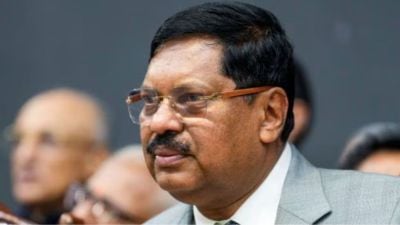Why I’m seceding to Kochi
UNTIL two days ago, I didn’t know what I would be writing about south India. The idea that a Pakistani—or any foreigner—shoul...

 UNTIL two days ago, I didn’t know what I would be writing about south India. The idea that a Pakistani—or any foreigner—should somehow be able to offer fresh insight about the region carries with it, intrinsically, a touch of condescension for the reader and no little intimidation for the writer.
UNTIL two days ago, I didn’t know what I would be writing about south India. The idea that a Pakistani—or any foreigner—should somehow be able to offer fresh insight about the region carries with it, intrinsically, a touch of condescension for the reader and no little intimidation for the writer.
For long I grimaced restlessly. Four states, four languages, four different cultures and hundreds of millions of people, hundreds of years of history; to even begin to grasp such vastness, such diversity in two weeks was unfathomable. To express it in 1,000 words, impossible. But cluelessness and ignorance, if manifest in endless queries and questions, take you a long way.
Since my arrival in India in March, I had barely felt her. Delhi had been too brief, Chandigarh and Mohali too planned and too close to the Punjab of Pakistan. In Kolkata, I had sensed her briefly through the throngs, through the creaking but graceful mass of colonial architecture and through ostentatious poverty. But the south of India, two weeks, surely I would feel.
Through my childhood, south India was someone called Rajnikant, something called Tamil Nadu and a school friend, Manzoor Karimuddin, originally from Chennai. Eventually, Rekha, Sridevi, Chinnaswamy, Chepauk and the Tamil dilemma emerged, but I still thought everyone in this area walked, wore sunglasses and flicked cigarettes into his mouth.
Now, having travelled through Chennai, Bangalore, Kochi and Vishakhapatnam there are no insights, no perceptions, nothing has been proved wrong, even less right.
IN Chennai, for six hours in a hotel room, I only wondered whether every man, by law, was to sport a moustache. For even those who didn’t, somehow seemed as if they should have had one, or had only recently shaved one off.
Bangalore is not Indian but still Indian; India Shining. I am still not sure, given the city’s cosmopolitan air, whether the capital of Karnataka qualifies as truly representative of the south. But discernible was a sense of siege here for locals, uncertain and maybe hostile at how ‘‘their’’ city of gardens and overwhelming greenery was mutating rapidly into a south Asian technology hub.
In any case, an identity wasn’t forthcoming; on MG Road, Brigade Road, with Baristas, Coffee Days and Planet Ms it was maybe lost—global, not local. Bars, pubs, restaurants, sprawling modern office blocks, banks, ATMs, brands; maybe locals were just defiant in the face of this onslaught from the market. And why not?
THIS feeling of invasion, of losing something, and not being sure whether what you have lost is good and gained bad, stuck with me. In Kochi and Vishakhapatnam, the question isn’t turned on its head, it is approached from different angles. There are surely fewer locations in the world blessed with as much exquisiteness as Kerala, and in particular Kochi.
Sir Charles Napier, upon the annexation of Sindh in 1843, was urged to say to my native Karachi: ‘‘You will yet be the glory of the East; would that I could come again, Karachi, to see you in your grandeur.’’ Had he travelled further south-east to Kochi, he might have said it again, and with more feeling.
I spent half a day on a houseboat and then a river boat gliding around the backwaters and islands around Kochi, thinking fully that, let alone India, this was like nowhere else in the world.
In eight hours I gorged on more visual splendour than 28 years, four countries and four continents had bestowed upon me. And in the middle of a gruelling, maddening 7,500 km cricket tour over 50 days, eight hours of idyll was priceless.
But Kochi, quaint, tranquil Kochi where I could retire, Kochi with an identity; even here you wonder.
At Fort Cochin, Chinese fishing nets and a sunset from postcards, tourists and locals were assaulted by people selling. The oldest Jewish synagogue in Asia, in Jew Town, is found only after you have walked down a path of consumer temptation; retailers on both sides who, upon spotting a camera, pounce before almost apologetically. At the end, rests the synagogue.
VISHAKHAPATNAM has quite a different but equally enticing landscape. Hill upon hill on one side is abruptly met by a coastline of unanticipated magnificence. It took me by utter surprise, having driven through town to be greeted suddenly by a glittering blue sea opposite near-white sandy beaches.
And yet the city looks untouched. The coastal drive, barring perched hotels, is strangely devoid of hustle and bustle. Should they not open bars and restaurants here and cash in as a tourist hotspot?
In Pakistan, where tourism lingers between nascent and non-existent, this wouldn’t even be a question. Mike Marqusee, writer and avid subcontinent traveller, was at the Bangalore test where we chatted briefly about the places he had visited in Pakistan, areas which, we both felt, deserve more attention than they get.
These areas need to be promoted, visited, written about in travel guides but, ultimately, at what cost? At the cost of losing their essence, the very character that makes them unique?
Broadly then a whiff of the great globalisation debate came and it was one I had sniffed elsewhere in India. But smaller, less grand wonderment also emerged. Communism, Marxism and socialism are credible and successful and there are street posters of Lenin and Guevara in Cochin.
As part of the subcontinent, it just seemed so not us to be communist. That is an ideology after all and, in Pakistan anyway, has never interfered with politics.
ONLY slightly less important was the cuisine. Almost incongruously, I have fallen in love with dosas, idlis, appams and string hoppers. Or with curries that aren’t heavy and are served in the morning yet still leave you content.
I relished, almost as much, the accent with which English is spoken in the south. If you speak to an Indian or Pakistani in New York, say, you might struggle to differentiate. But a south Indian, you can spot (although which state may be more difficult).
Not many other regions in the world are immediately recognisable from the way their people speak English. I fell in love with the way they speak through Mrs Karimuddin (my schoolfriend’s mother), who spoke with such a lilt and cut in her accent, such changes in tone, pitch and spirit, that it became swiftly addictive and hypnotic.
AND now south India is rooted in my head, forming, moulding, growing, shaping, questioning; more trips will be required for it to acquire tangibility. Was it different to north India? I don’t know for I don’t know India well.
What I do know is that it raised more questions in my head than answers. Maybe in north India I had seen fragments of Pakistan. Here, more exotically, I felt shards of Sri Lanka and even Mauritius but mostly I sensed an unknown. It intrigued me, teased me, surprised me, delighted me—and in a 14-hour bus ride from Kochi to Chennai, it tested me.
I can’t express it and I haven’t grasped it, but truly and regrettably, all too briefly, I felt India … south India.
Photos


- 01
- 02
- 03
- 04
- 05




























